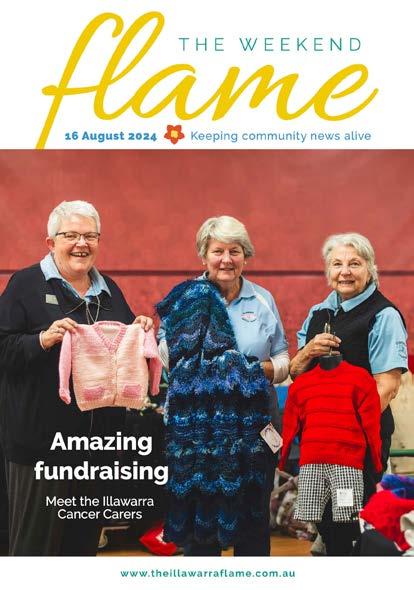




Fundraising event to support Austinmer Surf Club & raise funds for a new Inflatable Rescue Boat
Saturday 14th September | 6.30pm - 11.00pm | Headlands Hotel
Join us for a 3 course dinner, beverage package, club update and live entertainment, including a performance by Baker Boys.
Adults $135 Scan QR to purchase your tickets
The Apple Pie Bake-Off is back at Glenbernie Orchard!

Darkes Glenbernie Orchard’s Apple Pie Bake Off is back this weekend, August 24 & 25!
Join the fun and enter your finest pie or crumble - it’s FREE to enterno experience necessary - and you’ll also get a one-day free entry ticket to Spring Festival.
The Spring Festival this weekend will include live music, food, local
cider and beer, space for the kids to run and blossom walks.
Head over to Glenbernie Orchard’s Facebook page for more information.
A donation to Stanwell Park Country Women’s Association will be made by Darkes Glenbernie Orchard at the conclusion of Spring Festival to assist them with projects in our Northern Illawarra Community.
The exhibition will officially open at 6pm tonight, Friday, August 23
Do you see what I see? IAVA artists share their unique ways of seeing. What is it you see? How do you see this, and how do you portray your narrative visually? The artist is forever challenged by ‘what’ and ‘how’.
Welcome to the world of art where you, the audience, are able to see and engage with a breadth of representation, inspiration gleaned from historical and contemporary times… it is the art of now!
The latest exhibition by Illawarra Association for the Visual Artists (IAVA) titled ‘Ways of Seeing’ brings together 21 local artists celebrating creativity, at Project Contemporary Artspace.
The show runs until 8 September. Gallery Hours: Wednesday to Friday 10am-5pm. Saturdays and Sundays 11am-4pm
With works by Sue Bessell, Paola Birac, Judy Bourke, Jack Draper, Alannah Dreise, Margaret Dubowski, Gail Etheredge, Wendy Fogarty, Joan Harvey, Karen Heffernan, Sabina Hyung-Ran Choi, Lynne Johns, Liz Jeneid, Kathy Karas, Moira Kirkwood, Susan McAlister, Lilybeth Mayhew, Deborah Redwood, Lara Seresin, Mary Wingrave, Salwa Woodroffe.
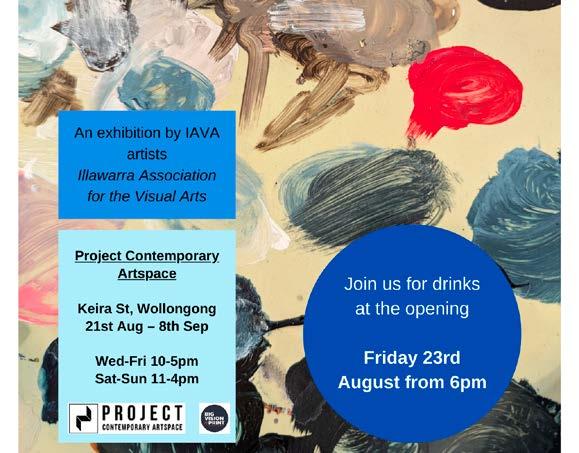

28 August
Literary Lunch with Sophie Green
Until Aug 24
Birdsong of Tomorrow at IPAC
From 31 August Illawarra Rhododendron and Rainforest Gardens - Spring Showcase
1 Sept Fancy Women’s Bike Ride
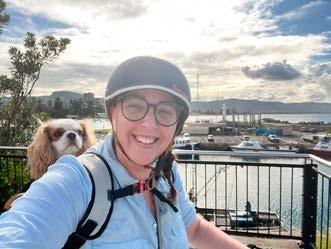
7 Sept Music 4 Medicine
7 Sept Creative Wollongong Short Film Festival
5-15 Sept
The Mousetrap
20-22 Sept
Folk by the Sea
26 Sept
The Women’s Adventure Film Tour 2024
Click here for more events
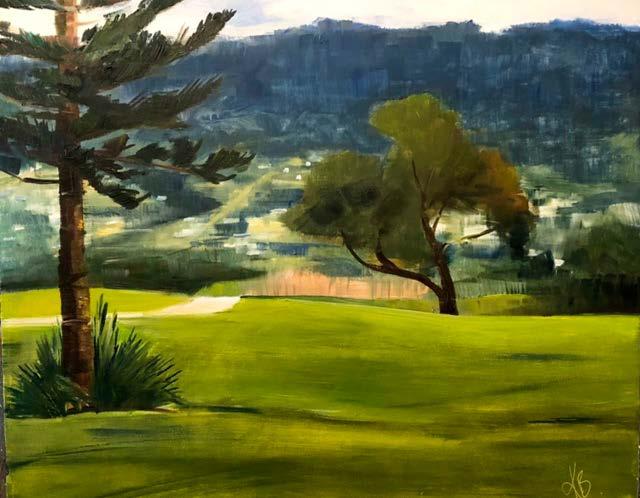

By Melissa Barnard

“I
paint almost everyday. It is such a calming activity and challenges my brain.”
– Kate Broadfoot
Kate and Peter Broadfoot have been Bulli residents for over 50 years, raising four children and working as teachers at Bulli High school before establishing Bonn Accord Arts and Crafts in Bulli.
After 18 years operating this art supply shop and painting studio Kate now pursues her love of pleinaire landscape painting, drawing on the local Northern Illawarra for her inspiration.
Usually painting in her car, Kate has become well known to locals as they see her out and about. She has developed a distinctive, fresh style of painting which perfectly captures many much-loved local views.
From where do you draw your creative inspiration?
I am a “pleinaire” artist, so I paint the landscape as I see it.
My inspiration is drawn from my local environment… and wherever we travel.
How do your art practice and your life intersect?
I paint almost everyday. It is such a calming activity and challenges my brain.
Now I have the time in my life that I have always craved, I go out painting whenever I can.
Can you tell us a little about your personal artistic journey?
After a career as a high school art teacher and then 18 years as proprietor of an art shop and teaching studio, I have at last found the time to pursue my love of pleinaire landscape painting.
What will you be bringing to 2024’s Scarborough Art Show?
This year I am bringing to the art show a few works featuring the Clifton School of Arts building, as it is such an iconic local site. The other paintings will be of our Northern Illawarra coastal views.
What do you enjoy about the Scarborough Art Show?
The Scarborough Art Show really provides the best overview of what is happening in the Illawarra art scene. I love seeing what other artists are doing in their work.
The work done by the P&C at Scarborough School to put on this annual show is absolutely amazing. Thank you so much for showcasing the work of local artists.
Scarborough Art Show will be back at Scarborough Public School on October 12th (10am5pm) & 13th (10am-2pm).


By Tyneesha Williams

Emerging local playwright and performer Nathan Harrison is bringing his thought-provoking show, Birdsong of Tomorrow, to the Illawarra Performing Arts Centre (IPAC).
Nathan says the show, performed from August 22 to 24 as part of the MerrigongX program, aims to give Wollongong audiences a new appreciation of birds.
“Birds have been around for such an incredibly long time and they pass down songs and have culture and memory.
“And I think maybe that’s a way to think about change in the world, obviously everything has changed a lot in the last few years, and it’s going to keep changing.”
Nathan often collaborates with science researchers to write interactive shows
that unpack ideas about the natural world.
“Chris Thorpe (UK theatre writer) says that a show needs to have a question that you can’t answer without an audience being there,” Nathan says.
“A lot of this show is me trying to use birds as a lens to think about change and absence and loss, how we can feel connected to people, the country that we’re on.
“The show asks how do we adapt to change? And how do we remember what isn’t here anymore?”
The ideas behind Birdsong of Tomorrow hatched after Nathan’s experience with a friendly magpie, a “Covid lockdown miracle”.
“At that point, like, everything felt very small. But that magpie just made me think a lot about time and how change happens,” Nathan says.
“It took me a really long time to really understand what the show was about. I’m really interested in birds, I’m really interested in change and things like that, but that’s not a theatre show.”
Nathan is joined in the production by director Emma McManus, sound designer Tom Hogan and production designers Solomon Thomas, Clare Britton and Troy Reid.
“A team came together of some of my favourite people and very dear friends to work on the show and everything just felt like it started to fall into place in a really lovely way,” Nathan says.
“We’re all really curious and eager to try things, and we really trust each other and have a good sense of what we’re adding to the show.
“It’s a show that all of our lives have influenced in different ways. It’s been a way for us to find connection, and work on something that feels pretty personal. There’s a lot of us in it.”
The show involves bird songs and visuals the team have gathered in a variety of ways while working together.
“We went to the Royal National Park for a day and took some cameras and some recording devices and got a lot of footage for the space,” Nathan says.
“It’s weird. You can make a video
really, really out of focus, but all you need is the tiny little movement and you’re like, ‘Oh, it’s a bird’.”
The team have worked with scientists, conservationists and ecologists who work with birds to put this show together.
“There’s a lot of research that’s gone into this show. Part of the show is kind of like a nature documentary or a science lecture.
“There are a lot of people who do a lot of interesting work around birds and how we think about birds. We have so many endangered birds in Australia and there are people doing incredible things trying to protect that.
“For a show about change and absence, we’re interested in conservation and extinction, so we’ve been talking to experts about that a lot.”
Audiences can expect to gain a new perspective and appreciation for the nature that surrounds them in Wollongong.
“It’s a pretty special place – literally between the mountains and the sea. I grew up at the foot of the escarpment. I had parrots and all sorts of birds in my garden,” Nathan says.
“A lot of the show is talking about birds as these things that are around us every day and we might not pay attention to, but they’re witnessing our world in a really beautiful way.
“I’d love for people to see the show and then maybe the next day they’re out and about and they see or hear a bird and it feels new.”
Birdsong of Tomorrow will be staged at IPAC on Thursday, August 22 to Saturday, August 24, starting at 7.30pm.
It is a MerrigongX show, so there is no set ticket price. Audiences can reserve a spot online, then pay what they feel the performance is worth after seeing it.
The show runs for 60 minutes without an interval and is suitable for ages 14 and up.
“Birds have been around for such an incredibly long time and they pass down songs and have culture and memory.
“And I think maybe that’s a way to think about change in the world.”
– Nathan Harrison
Reserve your seat via Merrigong’s website
By Tyneesha Williams
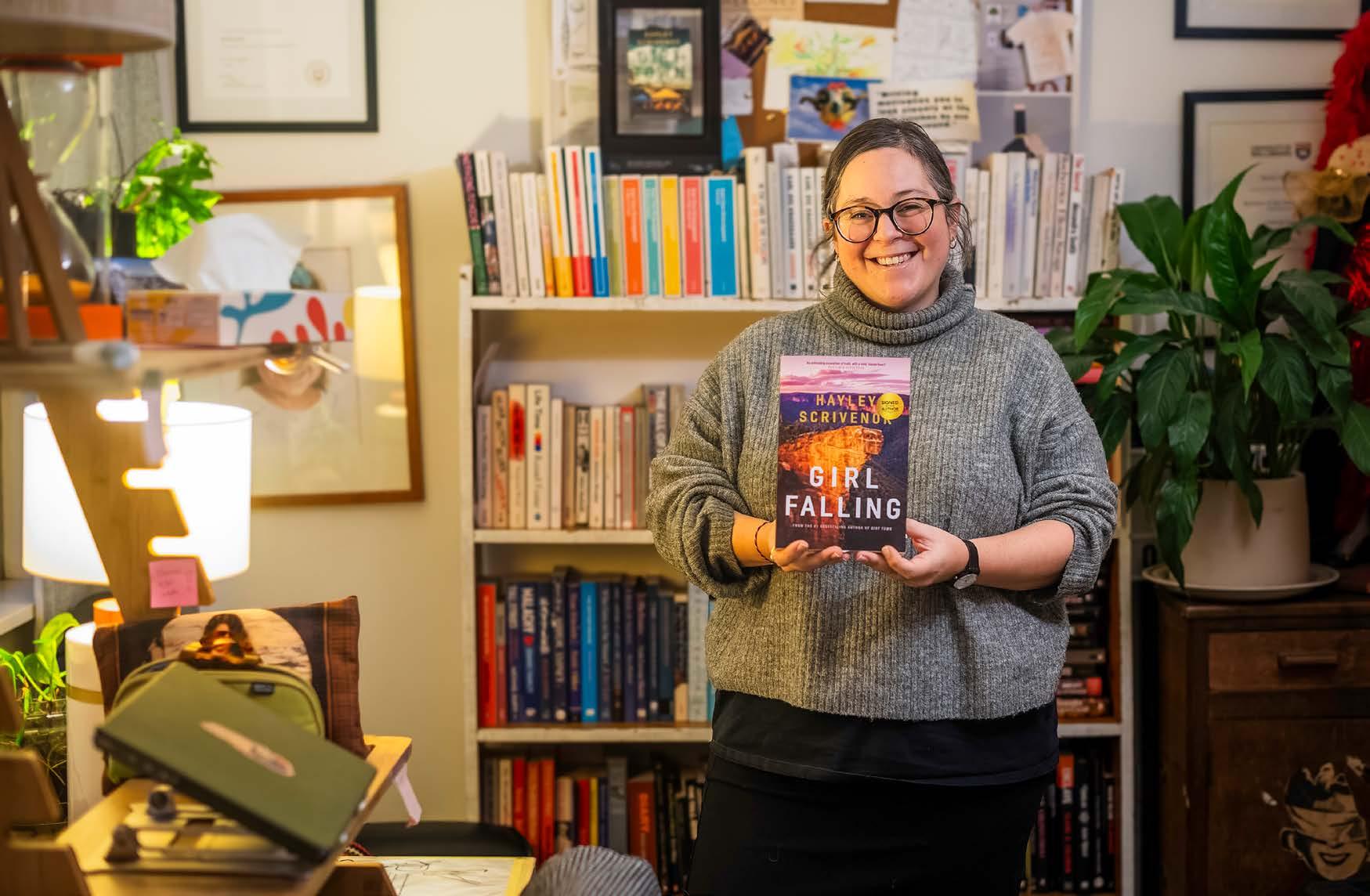
Wollongong-based author Hayley
Scrivenor is set to launch her eagerly anticipated second novel, Girl Falling, on Wednesday, August 21 at Ryan’s Hotel in Thirroul.
After the success of her debut novel and bestseller Dirt Town, Hayley delves into complex friendship dynamics and self-discovery in her latest crime fiction.
“Girl Falling came about because I wanted to write a story in the Blue Mountains. There’s a beautiful writing retreat there called Varuna, The National Writers’ House,” Hayley says.
“I was interested in exploring what happens when a complicated, very close friendship goes bad. I was also interested in that classic triangle… when you meet someone new and someone else in your
life is like ‘oh, hold on, like you’re no longer paying attention to me’.
“It’s a book that’s quite interested in psychology and in the question of how you know that your perceptions of people are the right perceptions. When relationships end or don’t go well, how do you know that it’s not your fault?”
Girl Falling focuses on the story of Finn, who navigates a complicated friendship with her best friend, Daphne, after falling in love with international student Magdu.
“Finn is a character that has a lot of shame. So when she meets a character, like Magdu, she enters a new world of someone who understands her in a way that her closest friend didn’t. I think bisexual women across the world can
understand very deeply that experience with a straight high school best friend,” Hayley says.
“I loved exploring the character of Daphne. She’s not anybody’s favourite character but I actually really love her. She has quite high standards for herself and really needs Finn to help her live up to them and be the person that she wants to be. But she makes some questionable decisions along the way,
“Magdu is probably most like me. She’s a reader and she’s goofy and she is actually not that much of an outdoor person.”
Hayley grew up in a small country town near Wagga Wagga before moving to Wollongong for high school.
“I’ve lived in various places but I keep coming back to Wollongong because I really love it here,” Hayley says.
“I think it is such a great place to live as a writer because there’s that feeling of having Mount Keira behind me and the ocean in front of me. I have a real sense of that in my study.”
In 2022, Hayley wrote Dirt Town as part of her PhD in creative writing at the University of Wollongong, where she also taught fiction writing.
“Dirt Town was shortlisted or won 11 awards, it won four big ones and was shortlisted for a range of national and international ones,” Hayley says.
“That was really unexpected for me. It was really lovely. Then I had a contract with my publisher to write a second.
Luckily, I started before Dirt Town came out because it meant that I was well underway with writing a story, which I think was less stressful than if I just sat down to a blank page.”
Dirt Town won the Australian Book Industry Awards’ General Fiction Book of the Year 2023, as well as the Crime Writers’ Association’s ILP John Creasey Dagger Award, The Lambda Literary Award for LGBTQ+ Mystery and The Davitt Awards Debut Crime Book 2023.
As an awarded writer, with the support of her publisher, Macmillan Australia, as well as the literary community, Hayley says that she felt more confident writing a second novel.
“Dirt Town was a hard book to write for a lot of reasons. But I’ve really tried this second time around to enjoy the process more… That’s the joy of writing your second book. You have your first book sitting on a shelf behind you. You kind of go, ‘Well, I’ve got at least an even chance of doing this again.”
Hayley says that crime fiction novels give readers a cathartic experience.
“I think we read crime because a story is a way of helping us feel like we understand the world and the bad things that might happen,” Hayley explains.
“What crime gives you is an answer. We don’t get an answer in life. We don’t get to know why people hurt us or why something bad happened 99% of the time. But in crime, the promise is that at the end, everything will come together.”

“I was interested in exploring what happens when a complicated, very close friendship goes bad.”
– Hayley Scrivenor
By Emma Rooksby of Growing Illawarra Natives

“Native
Daphne is in flower around the region, a little early as September is considered to be its peak flowering month” – Emma Rooksby
Oneof the sweetest-scented plants of the entire Illawarra region is also one of the most common, and most overlooked, species. Native Daphne, or Pittosporum undulatum, is a small to medium-sized tree, with a dark brown and often twisted trunk, glossy leaves with undulating margins, and flowers with the most heavenly scent.
Right now Native Daphne is in flower around the region, a little early as September is considered to be its peak flowering month, but get out there and enjoy it now!
The sweetly scented flowers of Native Daphne appear in compound clusters, with white petals and prominent yellow stamens (photo below by Byron McGregor-Cawthorne).
This tree can be seen in natural areas around the region, from the escarpment to the sea. It is widespread in rainforests, whether in littoral rainforest at the coast such as at Puckey’s Estate or Seven Mile Beach, or along the escarpment slopes, where it can grow into a tall and stately tree up to 20m high.
You can also see it in woodlands and sclerophyll forests, where it forms a component of the understorey, often growing up to around 3-5m high before being attacked by borers and losing its crown.
Woodland areas such as Purrungully Woodland in Horsley or Wiseman Park in Gwynneville are good places to see this plant in flower, as plants are smaller and flowers are more accessible. The Illawarra Rhododendron and Rainforest Gardens also have many good-sized specimens with accessible flowers – try the rainforest walk in the upper gardens.
The Native Daphne pictured at left is growing on the Ken Ausburn Track in Keiraville, just up from the University of Wollongong. The crown is neat and shapely, and perhaps the lower levels have been pruned from beneath by wallabies or goats. This specimen can easily be appreciated if you walk the track which takes you up towards the Mount Keira Ring Track and onwards to the summit. (Photo by Emma Rooksby.)
I almost never hear about this tree in a positive sense. It is somewhat maligned as being ‘weedy’ in certain situations, for example, in Sydney where altered nutrient regimes mean it pops up in heathland. And in the Illawarra, it is often overlooked, barely remarked on by walkers, bush regenerators or gardeners.
Yet it is a common component of the local ecology and worth appreciating, particularly right now when it is flowering so profusely and so sweetly. Get out and enjoy it this month or next.
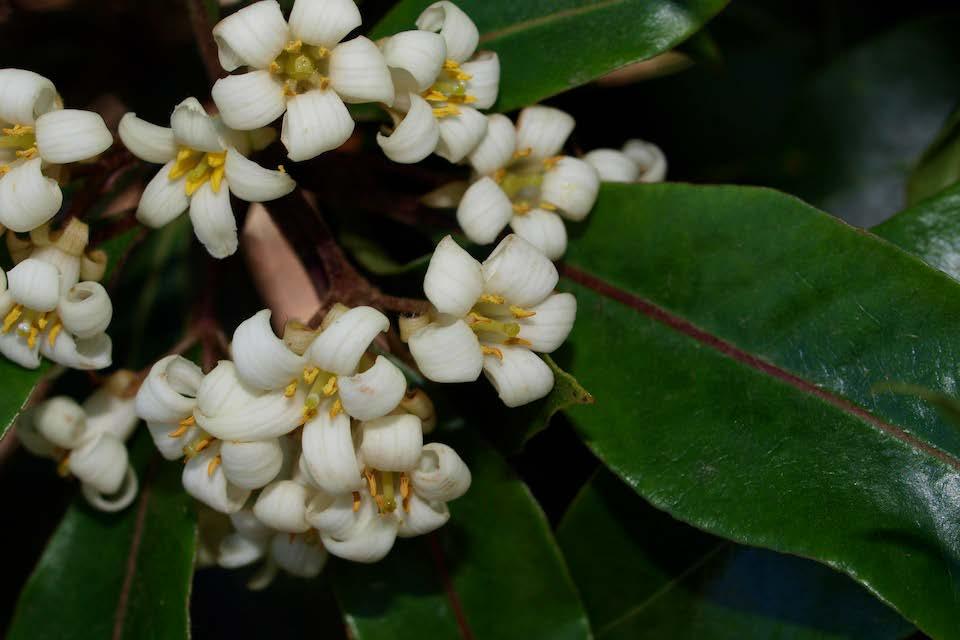
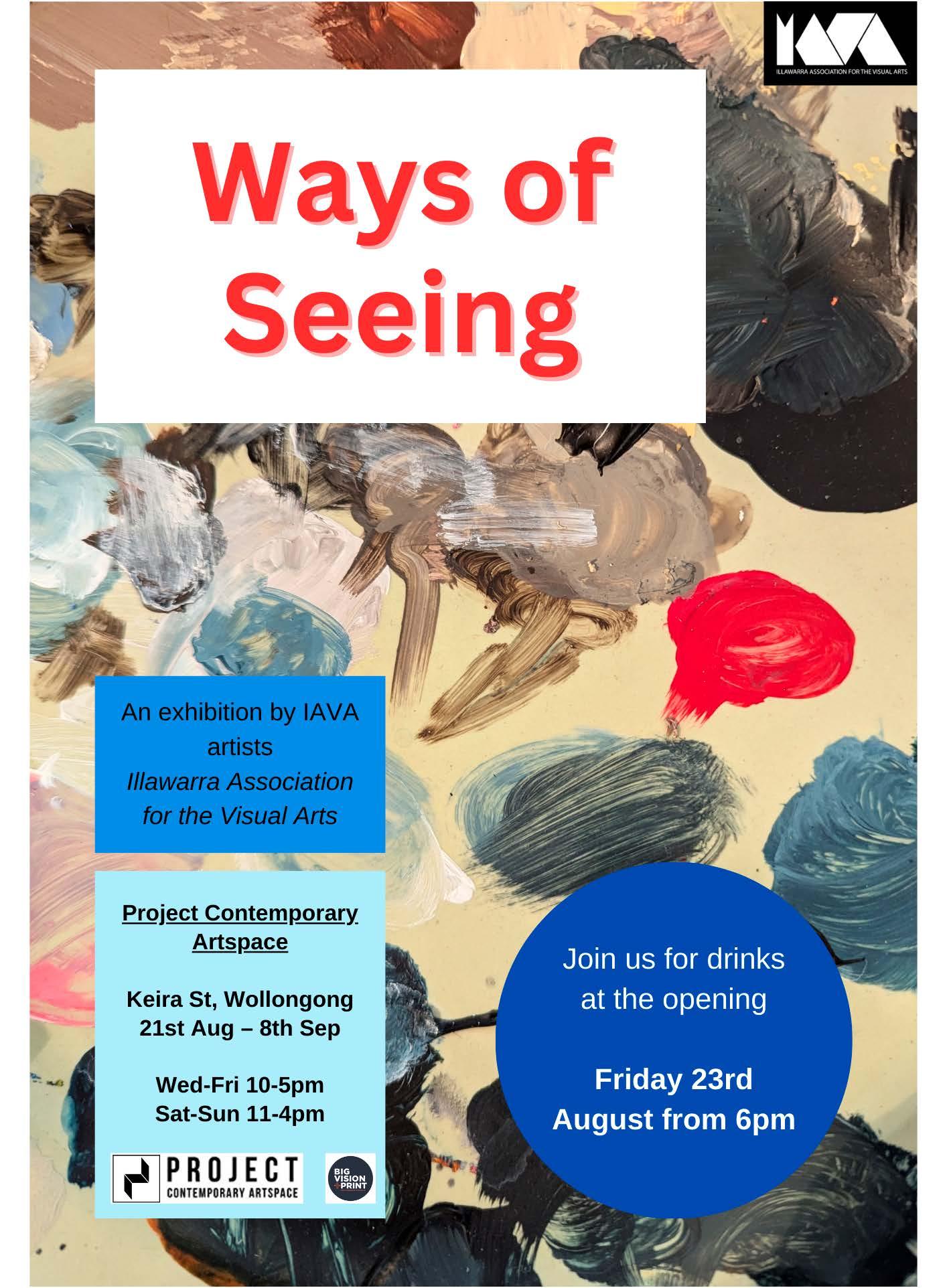
By Cathy Law
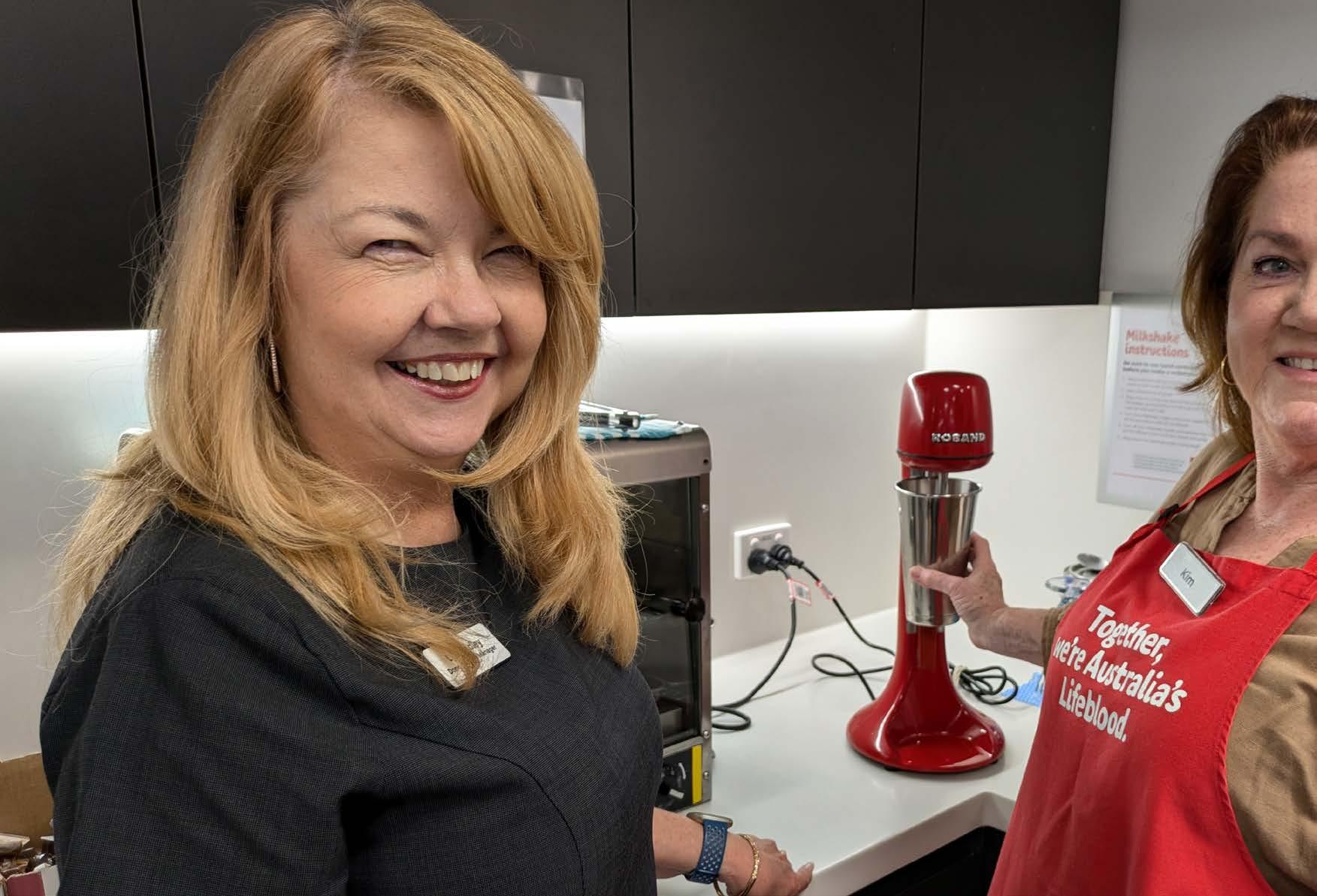
It’s usually hard to feel virtuous when drinking a milkshake and eating a sausage roll, but when you have them at a Lifeblood Donor Centre it’s part of your contribution to saving lives.
In addition to hydrating beforehand, a drink and a snack during the 15 to 20 minutes of relaxation after a blood donation is an important part of the process.
“It is a chance to sit back and relax in our cafe to give your body time to recover,” says Lifeblood Wollongong’s manager, Lyn Lindley.
“Many people say they feel it is a reward for doing something for others.
“It has the added benefit of helping to replenish what you’ve lost in fluids.”
Kim McKeen of Balgownie, who has just chalked up her 76th donation, enjoys her visits to the cafe, saying, “It is a lovely
social way of ending your visit and feels like a little treat for making the effort.”
Old school milkshakes are by far the most popular choice of post-donation drink, with some people saying it is the only time they have them.
If milkshakes aren’t your thing, there are other drinks to choose from, including tea, coffee and juices.
While the unmistakable aroma of sausage rolls and party pies tempts most donors, also on offer are packets of chips, biscuits, fruit cake, cheese and crackers, and the occasional chocolate.
“We want to make the whole experience a really good one, as retention of donors is so very important,” says Lyn.
“The volunteers who staff the cafe are an important part of our team.”
Figtree resident Kim Stylianou is one of those volunteers, having been
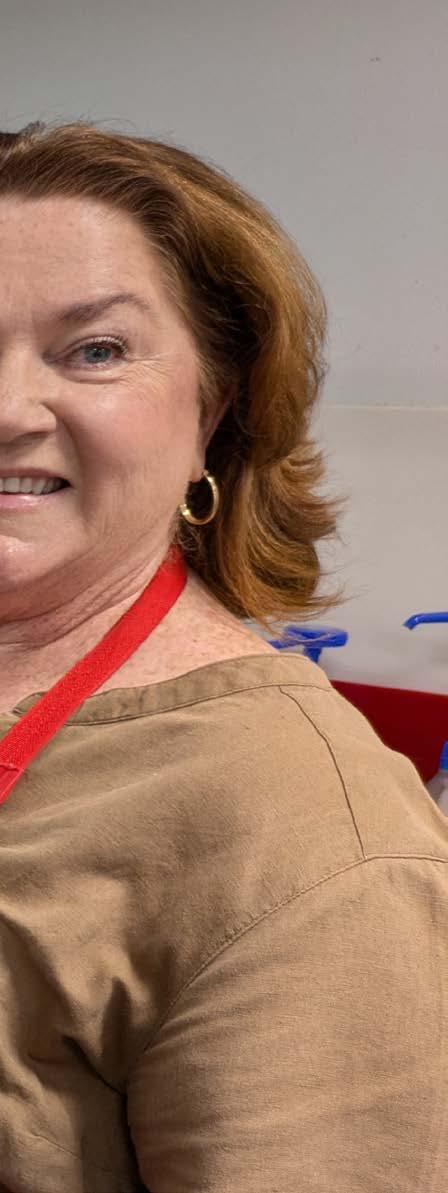
“We want to make the whole experience a really good one, as retention of donors is so very important.”
– Lifeblood Wollongong’s manager, Lyn Lindley.
attracted to the role through her own experience as a donor.
“I love the interaction with people who are all here with the common cause of helping others. It is a really special connection that touches me deep down,” she says.
“There is a great atmosphere, in part because people can order whatever they want with no bill at the end.”
Australia has more than half a million active donors who’ve donated blood products to help treat people with life-threatening conditions, including cancer, and during life-saving surgery. One donation can save up to three lives and donors are notified when their blood is despatched for use at a hospital.
“Winter is always a quiet time for donations, so we call out to anyone who is healthy to come along and help,” says Lyn.
The Wollongong centre on Kembla Street is open seven days a week, from 7am until 7 or 8pm, and can take up to 100 donors daily. People are encouraged to make an appointment, and parking is available onsite.
You can book a donation now by calling 13 14 95 or book online at lifeblood.com.au or via the DonateBlood app.
The Wollongong Donor Centre is at 45-53 Kembla Street. A Donor Bus also operates regionally for additional convenience.
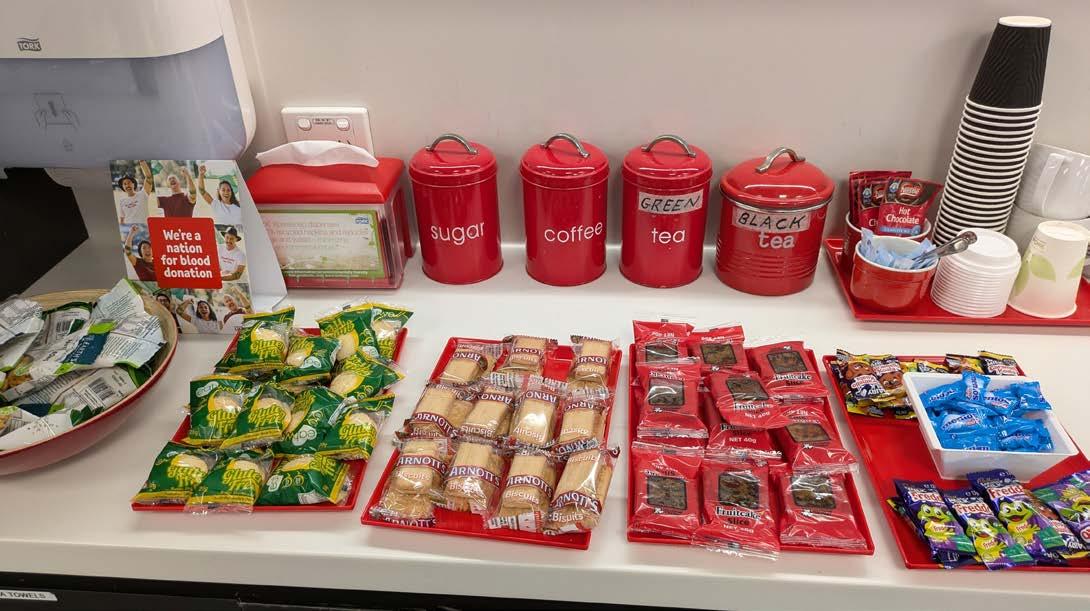
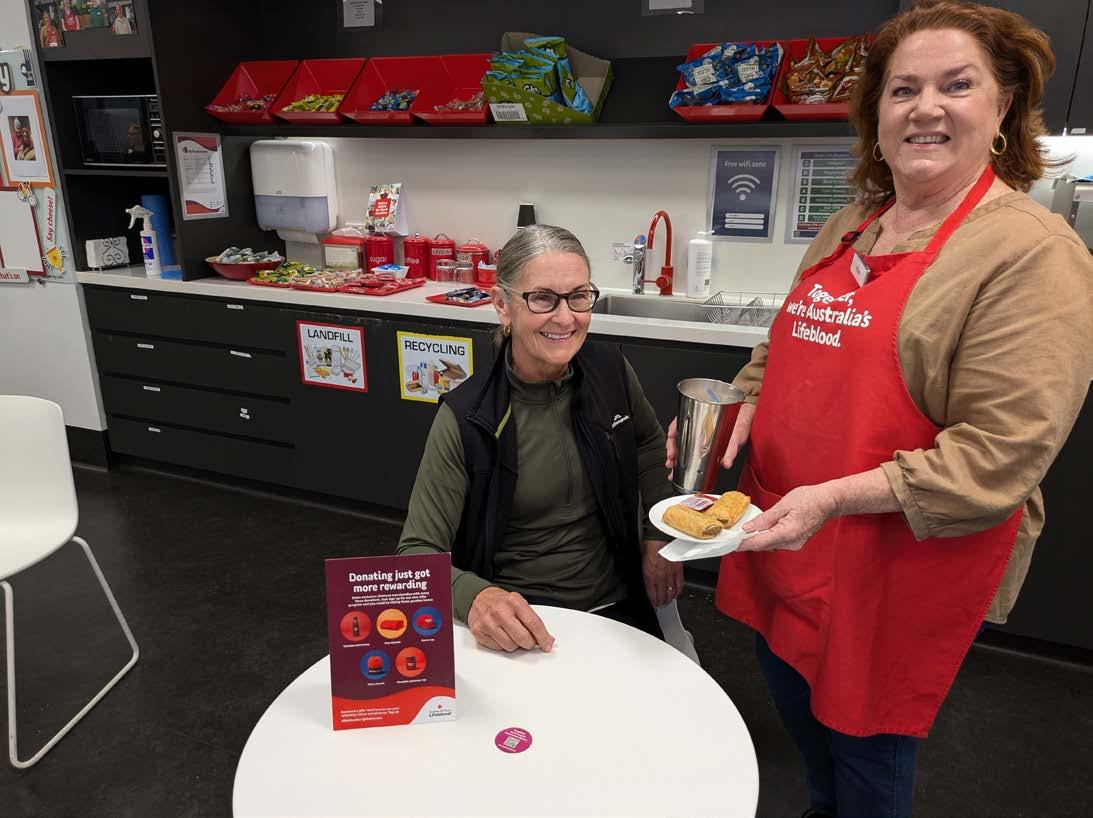

By Genevieve Swart
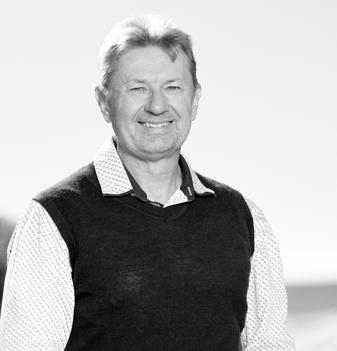
“The wires that connect your home to the grid are about as thick as your pinky at best. There’s only so much energy can flow through that wire.”
– Ty Christopher READ MORE
In this week’s instalment of our Energy Explained series, UOW’s Director of the Energy Futures Network, Ty Christopher, an electrical engineer with four decades’ experience in the power industry, explains fundamental laws of physics and why solar has its limits.
What percentage of the grid can solar realistically provide?
That is difficult to answer because if you start taking it at the total macro level, you’re not being fair to things.
I’ll give you an example.
Just think of it in terms of carbon footprint. 80% of the carbon footprint of the Illawarra is BlueScope Steel. So you could take all of the CBD, every single home, every business, the port, everything in the Illawarra to net zero carbon. And if you do nothing with BlueScope, at the end of all of that, you’ve still got 80% of your emissions.
So asking as a percentage of the grid in total what solar can contribute is not being fair to what it can do in terms of impact. Because the grid is dominated by these big energy users that have to have different types of solutions applied to decarbonise their activities, the big energy solutions.
So what I would say is that solar on homes and large solar arrays last year
(2023) generated around 23% of the energy into the grid in total over the course of the year.
At the moment, the rapid growth of both big solar and solar farms is starting to keep pace with home solar, now some of the Renewable Energy Zones are starting to unlock. But it’s fair to say that, in volume, the amount of solar coming into the grid is still dominated by solar on homes, not big solar farms.
There’s 23 gigawatts of solar capacity on homes at the moment in the grid. And there’s in the low teens of gigawatt capacity, in terms of big solar farms. So realistically, at this point in time, we’ve got a third of homes, give or take, and they’re currently contributing, call it around 15% of the energy into the grid from those homes.
So theoretically you could multiply that by another two times and you could get to say, 45% of the energy in the grid could come from solar on homes theoretically.
But I think saying that starts to ignore some of the fundamental laws of physics. The fact of it is that all of this lovely solar is connected to the grid via the skinniest wires in the grid.
The wires that connect your home to the grid are about as thick as your pinky at best. There’s only so much energy can flow through that wire, regardless of the
direction that it’s flowing, whether it’s being exported by the home or whether it’s being imported by the home.
And similarly, it connects to a not very much fatter wire in the street that is subject to those same fundamental laws of physics.
So what that means is, even if you were generating this massive amount of energy on all of these homes, the wires aren’t fat enough to get it to flow back up the grid to the high voltage components of the grid where it can transfer across and flow back down to big energy users, for example.
So the important focus of home energy generation and distributed energy resources such as solar on homes and solar on businesses, needs to be consumption of that solar generated electricity within the business and home, and then consumption of the solar generated electricity within the local street or streets where the energy is generated, because you are working within the physical limits, the physics of the thickness of the wires and their ability to transfer power around.
And what I think we’ll start to see is a natural saturation point where before we get to 100 percent of homes having solar, we get to a point where we are actually generating enough solar for that suburb already.
And the physics will actually dictate that you will hit the limit of what you can generate and use locally. The physics will probably kick in first, before we reach a point where every single home has solar.
And can those skinny wires ever be changed?
Of course, they can be changed – at great expense.
More so than building offshore wind, or nuclear?
You would be surprised. Mobilising people and machines and rebuilding existing electricity grids is tremendously expensive, especially when you start getting into areas with underground electricity assets.
As soon as you’re digging in the ground, it’s literally dig a hole, start throwing money in it, and then throw a match in and set fire to it.
It’s driveways restoration, people’s
gardens, think about all these new lovely suburbs with underground power and new landscaping, and going and just digging them all up and laying new and fatter wires.
And then the question is, well, how, how much larger wires do you lay? What technology will come later on?
So we’re talking billions, many, many billions of dollars.
There’s been studies done in the past going back two decades where there’s been calls for undergrounding all of the electricity grid and it came to tens of billions of dollars to underground the electricity grid just in New South Wales.
So can it be done?
The answer is: of course it can. I’m an engineer, throw money at me, I’ll give you anything you want. The question is, is that really in the best interest of us all as a community?
What’s the invested carbon in doing all of that work as opposed to getting our suburbs to the point where, as I would call it, they’re grid light in how they operate and they only propose a very modest electricity demand on the grid and that at a time when the electricity grid’s more than able to cope or whatever. And I’m talking here in the hours between midnight and 6:00 AM.
So if you can get the suburbs so that, through the course of the day, they are running on the sun and storing unused electricity both thermally (in hot water) and chemically (in batteries) through a combination of home batteries, EV car batteries, and community batteries, then we could extend the solar window past when the sun’s gone down right out towards eight or nine PM at night.
And then only at that later point in the evening would the suburb start to be putting a little bit of energy demand on the main grid.
And then the sun comes up in the morning, and rinse and repeat.
That looks to me like the best economic, the lowest net carbon footprint.
And if you’re sharing the energy equitably, the best social outcome for all of this, if for no other reason than it makes maximum utilisation of the billions of dollars of grid assets that are already there.
“You could take all of the CBD, every single home, every business, the port, everything in the Illawarra to net zero carbon. And if you do nothing with BlueScope, at the end of all of that, you’ve still got 80% of your emissions.”
– UOW’s Director of the Energy Futures Network, Ty Christopher
By Dr Andy Lawrence

Duringyour strolls in the sands of the Illawarra’s beaches, have you ever come across a small butterfly shell? Two chitinous wings flaring, the colours and striations giving the illusion of a moth fallen in flight to rest at the water’s edge. The coloured scales of the wings appear somehow untouched by the wash of salt water.
These winged shells are actually one section of the eight-part shell of a chiton. Most sea snails (molluscs) have only one or two parts to their outer shell. Think a whelk (single) or a mussel shell (two-parts). Chiton (pronounced “kai·tn”) have eight shell plates that fit together and are held in place by a muscular girdle or band that runs around the outside of the animal.
Although there are species differences in the shape of the shell plates, in general the head plate is crescent shaped, the six internal pieces are winged and resemble butterfly wings, and the shape of the anal plate is like a rising sun and reminds me of the ANZAC emblem. The individual plates can be beautifully coloured and shaped and when put together they form a functional protective shell. The combination of the girdle and the shape of the shell plates allows the animal to articulate its protective armour to manoeuvre over uneven rock surfaces and evade predators. Much like limpets, chitons stick to the hard surfaces like rocks and can be very difficult to dislodge. If they are picked off, chitons can roll into a ball to protect their soft
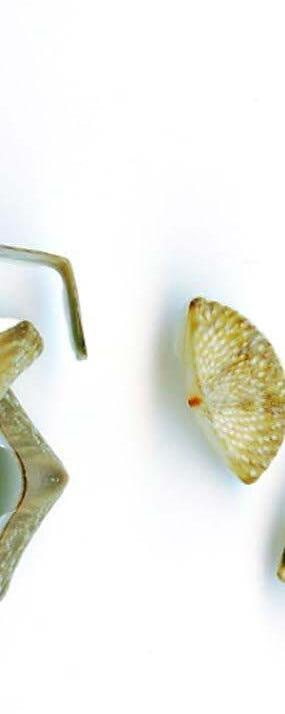
“Out of the roughly 1000 species found worldwide, Australia claims 150 of those. More impressively, 90% of those Australian species are endemic, found nowhere else.”
– Andy Lawrence
inner body. They remind me of a sessile, legless version of the grey slater bugs that scurry away after you dislodge the stone roof from their soil homes.
Although legless, they do have a foot, like all snails. That muscular foot provides grip and locomotion and contains a mouth and anus. The mouth features a hard radula, which is a modified tongue that they use to scrape algae from the rock surface.
Nearly all species of chitons are grazing herbivores. The girdle holds two primitive eye spots that detect light and dark. It’s been suggested that chitons have homing abilities that allow them to move about to forage and graze at night, then return to their ‘home base’ in the light of day.
Chitons live all over the world and although most live in the intertidal zone, some species occupy deeper ocean zones up to 6000 metres. Out of the roughly 1000 species found worldwide, Australia claims 150 of those. More impressively, 90% of those Australian species are endemic, found nowhere else.
Chitons belong in the class Polyplacophora, which comes from Greek origins meaning “bearing many
tablets/plates”. Their unusual shell structure has yielded some very literal common names as well: sea cradles, coatof-mail shells and, my personal favourite, suck-rocks.
Chitons breed externally, meaning that the males release sperm and the females release eggs into the water column simultaneously so fertilisation can occur.
After the chiton dies, the musculature that holds the plates in place breaks down and the eight plates come apart where they wash up on the beach. And that’s how we find them: as deconstructed remnants of a mollusc reminiscent of a Lepidopteran.
Pictured, Main image: Chiton plates. The crescent shaped head plates are at the top, the anal plates at the bottom and the winged intermediate plates in the middle. Image: Invertzoo, CC BY 3.0
Below: A common species on the south east coast of Australia: Sypharochiton pelliserpentis, snake skin chiton. Image: Mike Dickison, CC BY 4.0
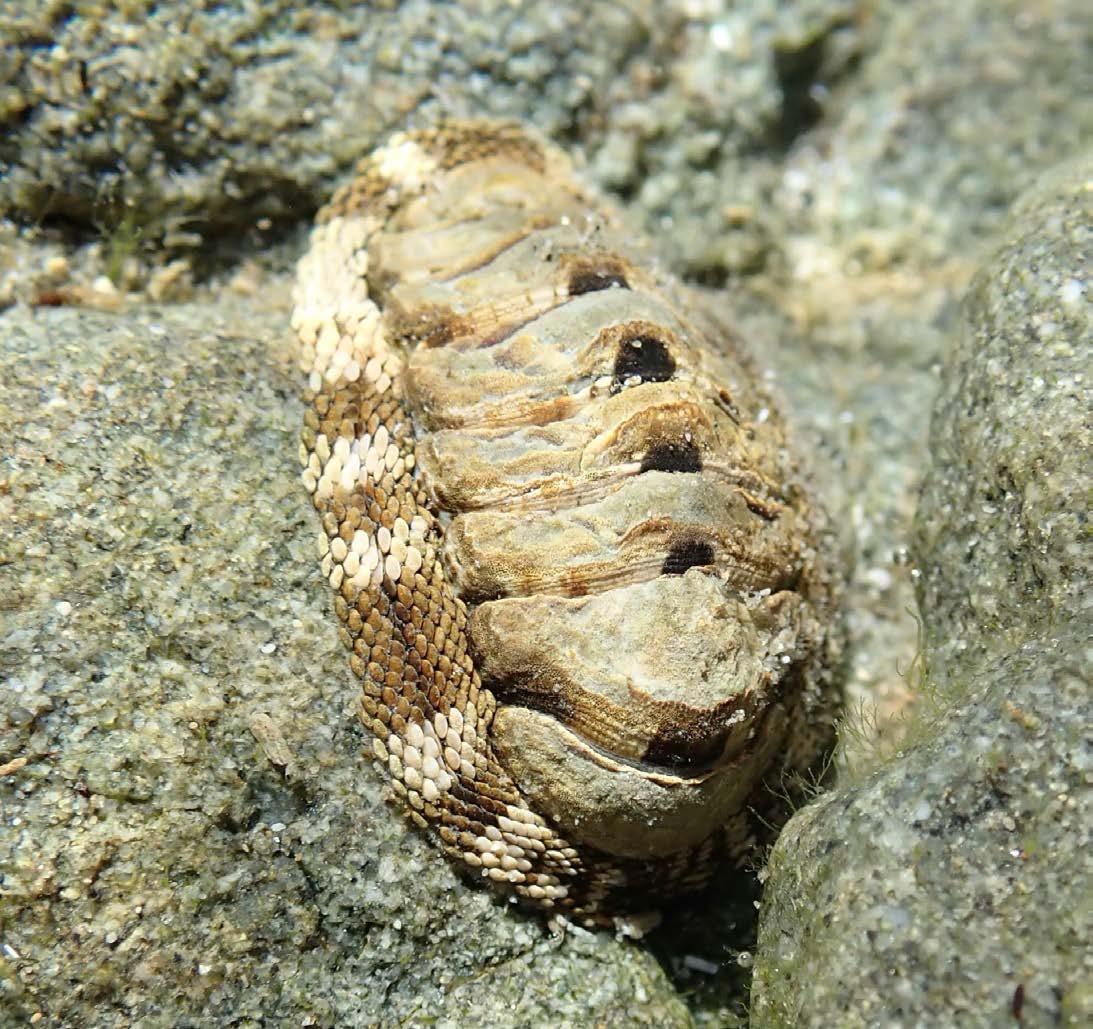
By Zach Houtenville
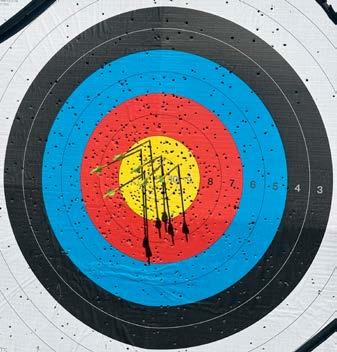
“This is going to sound weird, but it’s a little bit like a martial art”
– Fiona Hyde
Alocalarchery club with more than 50 years of competitive history in its quiver is the go-to group for aspiring and seasoned archers in the Illawarra.
The Illawarra Archers is a non-profit organisation founded in the 1960s and now, with 190 members, it’s one of NSW’s largest archery clubs. Affiliated with the Archery Society of NSW, Archery Australia, and World Archery, the club offers its members daylight access seven days a week at its scenic bush location on Mt Keira.
“This is going to sound weird, but it’s a little bit like a martial art,” said Fiona Hyde, member of the Illawarra Archers for 38 years and their club recorder.
“It’s mastering yourself, mastering your nerves, your skills and improving those skills.”
Archery requires precision, concentration and disciplin, and all of those skills help with real-world resilience. Anyone can pick up a bow and develop archery skills, whether they’re a young child or an adult.
Beginners at the club are required to pay a shooting fee and take an introductory course, followed by additional beginner courses to help them to develop their skills at their own pace.
Fiona said members are “welcoming to everybody”.
The club holds a weekly tournament every Saturday to give anyone interested a taste of competitive archery. Thanks to the club’s connections with major archery programs, Illawarra Archers’ members can find events across Australia in which to compete.
As archers improve, they may participate in qualifying and ranking events to gain a spot on the National Ranking List. This opens the door to international competitions, such as the Archery World Cup, for which Archery Australia selects teams from that list, often giving newer archers a chance to gain valuable experience at a high level.
“The opportunity is there if you’re competitive and you want to compete higher, you’ve got the pathway to do that,” Fiona said.
Last weekend, the club hosted the South Coast Field Day tournament. This event featured 24 targets set in the bush, with participants shooting at one target before moving to the next. Open to locals and archers from around the state, it served as a preliminary event for the 2024 NSW State Field Championships on September 7 and 8.
The Illawarra Archers’ next introductory course is scheduled for September 1, followed by beginner courses on September 15 and 29.
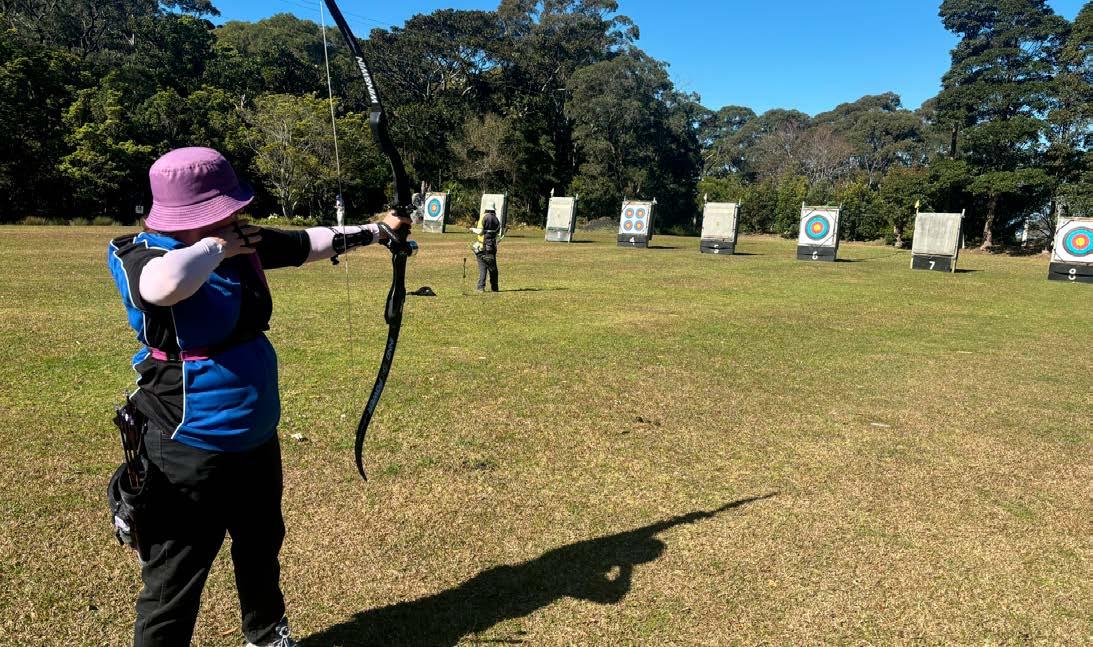

By Zachary Houtenville
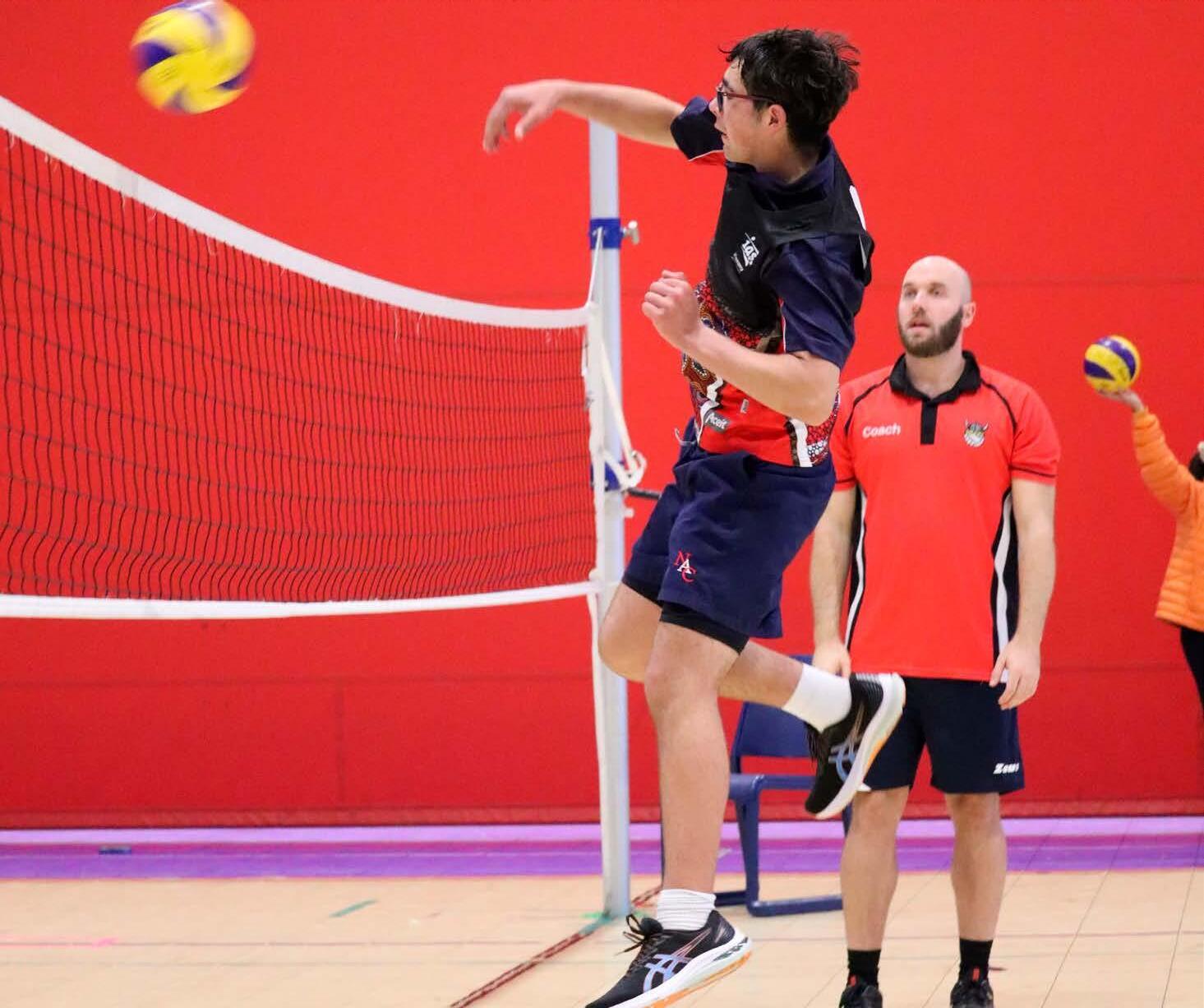
The
Illawarra Academy of Sport is inviting regional athletes to apply for 2024-25 scholarships.
This new intake, from October 2024 to September 2025, will benefit from the IAS’s top-level training and education aimed at turning athletes’ sporting dreams into reality.
“The question is always: How can we really support these athletes?” said Salv Carmusciano, CEO of the IAS.
“It might be just putting more resources into strength and conditioning or getting better equipment.
“It’s always about looking for ways to improve things for the athletes.”
This intake excites the IAS as athletes could have the chance to compete in some of the world’s top sporting events, including the Brisbane 2032 Olympics.
Training future Olympians is nothing new for the IAS. Six-time Olympic gold medallist Emma McKeon, Olympic hockey player Blake Govers and 400-metre hurdler Sarah Carli, who competed at the Tokyo Games, all attended the academy.
Who should apply
“I think they’ve already been identified as talented in their field, generally you’ve got just that extra level of hunger and commitment into whatever it is,”
Salv said.
“That includes everything we throw at them here at the academy, that they know and are committed to making themselves the best version of themselves as they can.”
Last year, there were about 500 applicants, but fewer than 300 were selected for the scholarship program, highlighting its competitive nature.
The academy employs the Foundations, Talent, Elite, Mastery (FTEM) framework, developed by the Australian Institute of Sport, to guide its selection process.
Athletes must be identified as talented, entering at the “T” phase, which focuses on recognising and nurturing athletic potential. The program aims to move athletes through various stages, from early talent recognition (T1, T2) to more advanced phases (T3, T4), ultimately preparing them for elite performance.
A key trait many athletes need to have is commitment, not only to get the scholarship but in order to fulfil all that comes with it.
“We test them, we challenge them but it gets the best out of them,” Salv said.
“It’s obviously working with their coaches really closely, attending every training session.
“Once you’re there and a chance for a scholarship, you still need that high level of commitment to be able to get through.”
With help from the local city council and the state government via the Office of Sport, the application process is free of charge. This 40-year partnership between the academy and local government gives IAS students a big leg-up, which also includes providing athletes with free access to local gyms to train under coaches.
“It’s a fantastic benefit to local athletes who are trying to make their dreams come true,” Salv said.
The academy often hosts events to build community among the athletes, including the Indigenous Talent ID Day on August 27.
This event aims to identify talented young Aboriginal, Torres Strait Islander or First Nations descent students for upcoming scholarships, testing athletes’ abilities across various sports and offering strength and conditioning sessions. Attendees will also learn about the support available to young athletes and enjoy a free lunch.
Athletes aged 12 and 18 may apply for an IAS scholarship via the Illawarra Academy of Sport website.
Applications are typically open until the end of August.
“It’s a fantastic benefit to local athletes who are trying to make their dreams come true.”
– Salv Carmusciano, CEO of the Illawarra Academy of Sport
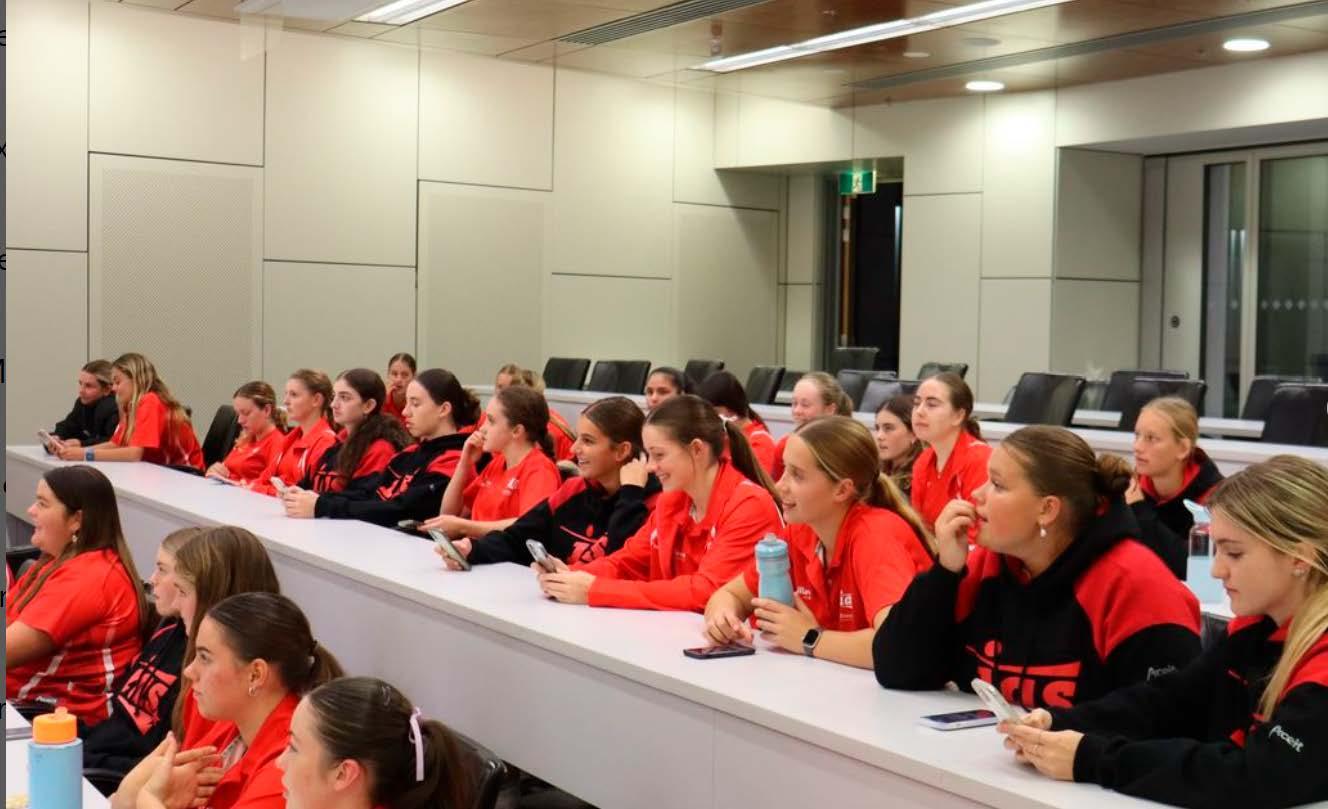
Support independent local news for $5 a month and you’ll receive the Weekend Flame + access to all our interactive digital puzzles

